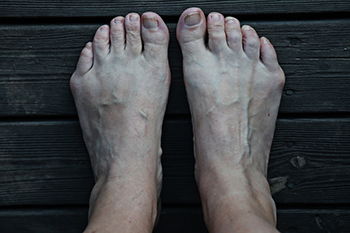
Bunionettes, also known as tailor's bunions, are bony bumps that develop on the outside of the foot, near the base of the pinky toe. Understanding the definition and underlying causes of these foot deformities is vital for effective management and prevention. Essentially, a bunionette forms when the bone at the base of the fifth toe protrudes outward, often accompanied by the misalignment of the toe joint. This condition is primarily attributed to structural imbalances in the foot, including inherited foot shapes, abnormal foot mechanics, or wearing narrow shoes that compress the toes. Over time, pressure and friction on the affected area can exacerbate the deformity, leading to pain, inflammation, and difficulty wearing certain footwear. While bunions and bunionettes share similar characteristics, they affect different areas of the foot. Bunionettes typically develop on the outer edge of the foot, whereas bunions occur at the base of the big toe. If you have developed a bunion or bunionette, it is suggested that you visit a podiatrist who can determine what the best course of treatment is for you.
If you are suffering from bunions, contact one of our podiatrists of McKinney Podiatric Associates, PA. Our doctors can provide the care you need to keep you pain-free and on your feet.
What Is a Bunion?
A bunion is formed of swollen tissue or an enlargement of boney growth, usually located at the base joint of the toe that connects to the foot. The swelling occurs due to the bones in the big toe shifting inward, which impacts the other toes of the foot. This causes the area around the base of the big toe to become inflamed and painful.
Why Do Bunions Form?
Genetics – Susceptibility to bunions are often hereditary
Stress on the feet – Poorly fitted and uncomfortable footwear that places stress on feet, such as heels, can worsen existing bunions
How Are Bunions Diagnosed?
Doctors often perform two tests – blood tests and x-rays – when trying to diagnose bunions, especially in the early stages of development. Blood tests help determine if the foot pain is being caused by something else, such as arthritis, while x-rays provide a clear picture of your bone structure to your doctor.
How Are Bunions Treated?
If you have any questions, please feel free to contact one of our offices located in Pasadena, Baytown, League City, Houston, and Pearland,TX . We offer the newest diagnostic and treatment technologies for all your foot care needs.
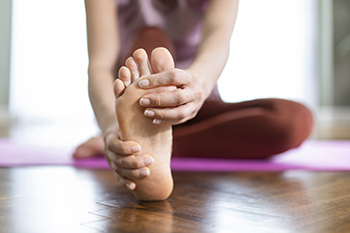
Brittle toenails can lead to discomfort and even pain. They can occur due to factors such as aging, repetitive trauma, fungal infections, or nutritional deficiencies. Individuals most prone to brittle toenails are often women, older adults, athletes engaging in high-impact activities, or those with certain medical conditions like diabetes or thyroid disorders. Brittle toenails can cause pain by becoming jagged or splitting, leading to ingrown toenails or infections. A podiatrist can offer several solutions to alleviate discomfort and address the underlying causes. They may recommend proper nail care techniques, such as keeping nails trimmed and moisturized, or suggest dietary supplements to improve nail health. Treatments for underlying conditions like fungal infections or medical management for systemic issues may also be provided. Additionally, custom orthotics can offer support and alleviate pressure on the feet, promoting overall foot health and reducing discomfort associated with brittle toenails. If you suffer from brittle toenails, it is suggested that you schedule an appointment with a podiatrist for consultation and care.
Toe pain can disrupt your daily activities. If you have any concerns, contact one of our podiatrists of McKinney Podiatric Associates, PA. Our doctors can provide the care you need to keep you pain-free and on your feet.
What Causes Toe Pain?
Most severe toe pain is caused due to a sports injury, trauma from dropping something heavy on the toe, or bumping into something rigid. Other problems can develop over time for various reasons.
Toe pain can be caused by one or more ailments. The most common include:
When to See a Podiatrist
Diagnosis
In many cases the cause of toe pain is obvious, but in others, a podiatrist may want to use more advanced methods to determine the problem. These can range from simple visual inspections and sensation tests to X-rays and MRI scans. Prior medical history, family medical history, and any recent physical traumatic events will all be taken into consideration for a proper diagnosis.
Treatment
Treatments for toe pain and injuries vary and may include shoe inserts, padding, taping, medicines, injections, and in some cases, surgery. If you believe that you have broken a toe, please see a podiatrist as soon as possible.
If you have any questions please feel free to contact one of our offices located in Pasadena, Baytown, League City, Houston, and Pearland,TX . We offer the newest diagnostic tools and technology to treat your foot and ankle needs.

Heel pain is a common complaint among children and adolescents, with one of the prevalent causes being Sever's disease, also known as calcaneal apophysitis. This condition typically affects active children during growth spurts, usually between the ages of eight and 14. Sever's disease occurs when the growth plate at the back of the heel becomes inflamed due to repetitive stress or overuse. The primary symptom is heel pain, particularly during physical activities or walking, which may worsen over time if left untreated. Diagnosis of Sever's disease involves a comprehensive assessment by a podiatrist, including a physical examination and medical history review. Imaging tests such as X-rays may be ordered to rule out other potential causes of heel pain and confirm the diagnosis. Treatment options for Sever's disease focus on reducing inflammation and managing symptoms, which may include rest, stretching exercises, and wearing supportive footwear, and orthotic inserts. It is suggested that you schedule an appointment with a podiatrist if your active child has heel pain, who can provide an accurate diagnosis and treatment plan.
Sever's disease often occurs in children and teens. If your child is experiencing foot or ankle pain, see one of our podiatrists from McKinney Podiatric Associates, PA. Our doctors can treat your child’s foot and ankle needs.
Sever’s Disease
Sever’s disease is also known as calcaneal apophysitis, which is a medical condition that causes heel pain I none or both feet. The disease is known to affect children between the ages of 8 and 14.
Sever’s disease occurs when part of the child’s heel known as the growth plate (calcaneal epiphysis) is attached to the Achilles tendon. This area can suffer injury when the muscles and tendons of the growing foot do not keep pace with bone growth. Therefore, the constant pain which one experiences at the back of the heel will make the child unable to put any weight on the heel. The child is then forced to walk on their toes.
Symptoms
Acute pain – Pain associated with Sever’s disease is usually felt in the heel when the child engages in physical activity such as walking, jumping and or running.
Highly active – Children who are very active are among the most susceptible in experiencing Sever’s disease, because of the stress and tension placed on their feet.
If you have any questions, please feel free to contact one of our offices located in Pasadena, Baytown, League City, Houston, and Pearland,TX . We offer the newest diagnostic and treatment technologies for all your foot and ankle injuries.
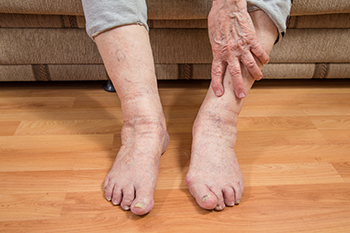
As we age, our feet undergo significant changes that may affect their appearance, function, and comfort. One of the most noticeable signs of aging feet is the development of wrinkles and thinning skin, which can result from decreased elasticity and collagen production. Additionally, the natural fat padding on the soles of the feet diminishes over time, leading to a loss of cushioning and increased susceptibility to pain and pressure. Other common signs include changes in toenail thickness and shape, as well as the formation of corns, calluses, and bunions due to years of wear and tear. Arthritic changes may also manifest in the form of stiffness, swelling, and joint deformities, making it more challenging to move and maintain balance. If you have encountered foot problems as you age, it is suggested that you confer with a podiatrist who can help you with effective remedies.
Proper foot care is something many older adults forget to consider. If you have any concerns about your feet and ankles, contact one of our podiatrists from McKinney Podiatric Associates, PA. Our doctors can provide the care you need to keep you pain-free and on your feet.
The Elderly and Their Feet
As we age we start to notice many changes in our body, but the elder population may not notice them right away. Medical conditions may prevent the elderly to take notice of their foot health right away. Poor vision is a lead contributor to not taking action for the elderly.
Common Conditions
Susceptible Infections
Diabetes and poor circulation can cause general loss of sensitivity over the years, turning a simple cut into a serious issue.
If you have any questions please feel free to contact one of our offices located in Pasadena, Baytown, League City, Houston, and Pearland,TX . We offer the newest diagnostic and treatment technologies for all your foot and ankle needs.

Kohler's disease, a rare foot condition primarily affecting children, involves the temporary interruption of blood supply to the navicular bone in the foot, leading to bone damage and subsequent pain. Typically occurring between the ages of 4 and 7, Kohler's disease manifests gradually, with such symptoms as localized swelling, tenderness, and difficulty in bearing weight on the affected foot. Children may also start limping or change their gait pattern as they try to alleviate discomfort. While the exact cause remains unclear, theories suggest factors such as vascular insufficiency or mechanical stress on the bone. Diagnosis often involves physical examination, imaging studies like X-rays, and ruling out other potential conditions. Treatment focuses on relieving symptoms and promoting healing, typically through rest, orthotic devices, and pain management strategies. Fortunately, most children recover fully without long-term complications, but early detection and intervention remain essential for optimal outcomes. If your child has symptoms of Kohler’s disease, it is strongly suggested that you make regular appointments with a podiatrist who can offer treatment and management techniques.
Some foot conditions may require additional professional care. If you have any concerns, contact one of our podiatrists of McKinney Podiatric Associates, PA. Our doctors can provide the care you need to keep you pain-free and on your feet.
Rare Foot Conditions
The majority of foot conditions are common and can be treated by a podiatrist. Standard diagnostic procedures are generally used to identify specific conditions and treatment can be rendered. A podiatrist also treats rare foot conditions which can be difficult to diagnose and may need extra attention and care.
There are many rare foot conditions that can affect children. Some of these can include:
Freiberg’s disease - This can be seen as a deterioration and flattening of a metatarsal bone that exists in the ball of the foot. It typically affects pre-teen and teenage girls, but can affect anyone at any age. Symptoms that can accompany this can be swelling, stiffness, and the patient may limp.
Kohler’s disease - This often targets the bone in the arch of the foot and affects younger boys. It can lead to an interruption of the blood supply which ultimately can lead to bone deterioration. The patient may limp or experience tenderness, swelling, and redness.
Maffucci syndrome - This affects the long bones in a child’s foot leading to the development of abnormal bone lesions. They are benign growths and typically develop in early childhood and the bones may be susceptible to breaking.
A podiatrist can properly diagnose and treat all types of rare foot conditions. If your child is affected by any of these symptoms or conditions, please don’t hesitate to call our office so the correct treatment method can begin.
If you have any questions please feel free to contact one of our offices located in Pasadena, Baytown, League City, Houston, and Pearland,TX . We offer the newest diagnostic tools and technology to treat your foot and ankle needs.
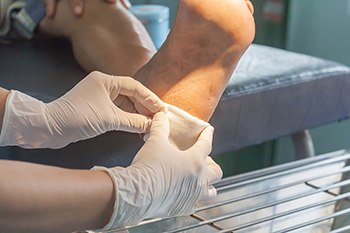
Diabetics can reduce the risk of developing foot ulcers by adopting proactive foot care measures. Regularly inspecting the feet for any signs of injury, such as cuts, blisters, or redness, and promptly having any wounds checked is imperative. Maintaining proper foot hygiene, including washing and thoroughly drying the feet daily, helps prevent infections. Wearing well-fitting, supportive footwear and avoiding walking barefoot further lowers the risk of developing ulcers. Additionally, managing blood sugar levels through diet, exercise, and medication is essential for overall diabetes management and minimizing complications. The prevalence of diabetic foot ulcers is significant, with complications ranging from infections to more severe issues like gangrene, which may necessitate amputation if left untreated. Regular visits to a podiatrist for foot assessments and care are essential for diabetic individuals, with frequency determined by the severity of their condition and individual risk factors. If you have diabetes and experience foot ulcers, it is strongly suggested that you schedule an appointment with a podiatrist for treatment.
Wound care is an important part in dealing with diabetes. If you have diabetes and a foot wound or would like more information about wound care for diabetics, consult with one of our podiatrists from McKinney Podiatric Associates, PA. Our doctors will assess your condition and provide you with quality foot and ankle treatment.
What Is Wound Care?
Wound care is the practice of taking proper care of a wound. This can range from the smallest to the largest of wounds. While everyone can benefit from proper wound care, it is much more important for diabetics. Diabetics often suffer from poor blood circulation which causes wounds to heal much slower than they would in a non-diabetic.
What Is the Importance of Wound Care?
While it may not seem apparent with small ulcers on the foot, for diabetics, any size ulcer can become infected. Diabetics often also suffer from neuropathy, or nerve loss. This means they might not even feel when they have an ulcer on their foot. If the wound becomes severely infected, amputation may be necessary. Therefore, it is of the upmost importance to properly care for any and all foot wounds.
How to Care for Wounds
The best way to care for foot wounds is to prevent them. For diabetics, this means daily inspections of the feet for any signs of abnormalities or ulcers. It is also recommended to see a podiatrist several times a year for a foot inspection. If you do have an ulcer, run the wound under water to clear dirt from the wound; then apply antibiotic ointment to the wound and cover with a bandage. Bandages should be changed daily and keeping pressure off the wound is smart. It is advised to see a podiatrist, who can keep an eye on it.
If you have any questions, please feel free to contact one of our offices located in Pasadena, Baytown, League City, Houston, and Pearland,TX . We offer the newest diagnostic and treatment technologies for all your foot care needs.
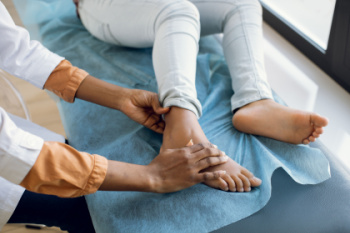
Foot pain is a prevalent complaint that can disrupt daily activities and diminish quality of life. Several factors contribute to this discomfort, ranging from overuse injuries to underlying medical conditions. One common cause of foot pain is plantar fasciitis, which occurs when the band of tissue supporting the arch of the foot becomes inflamed due to excessive strain or stress. Similarly, Achilles tendonitis, characterized by inflammation of the Achilles tendon at the back of the heel, often results from overuse or improper footwear. Bunions, structural abnormalities of the foot, and ingrown toenails can also cause significant discomfort and pain. Additionally, conditions such as arthritis, diabetes, and neuropathy may manifest as foot pain. Seeking medical advice from a podiatrist is vital for an accurate diagnosis and appropriate treatment to alleviate foot pain and prevent further complications. If you have developed foot pain, it is suggested that you are under the care of this type of doctor who can provide an accurate diagnosis and offer correct treatment options.
Foot Pain
Foot pain can be extremely painful and debilitating. If you have a foot pain, consult with one of our podiatrists from McKinney Podiatric Associates, PA. Our doctors will assess your condition and provide you with quality foot and ankle treatment.
Causes
Foot pain is a very broad condition that could be caused by one or more ailments. The most common include:
Diagnosis
To figure out the cause of foot pain, podiatrists utilize several different methods. This can range from simple visual inspections and sensation tests to X-rays and MRI scans. Prior medical history, family medical history, and any recent physical traumatic events will all be taken into consideration for a proper diagnosis.
Treatment
Treatment depends upon the cause of the foot pain. Whether it is resting, staying off the foot, or having surgery; podiatrists have a number of treatment options available for foot pain.
If you have any questions, please feel free to contact one of our offices located in Pasadena, Baytown, League City, Houston, and Pearland,TX . We offer the newest diagnostic and treatment technologies for all your foot care needs.
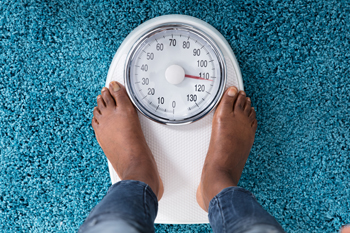
Obesity and foot pain often share a close relationship, intertwining in ways that impact an individual's mobility and overall quality of life. Excess weight puts undue stress on the feet, leading to various painful conditions, such as plantar fasciitis, flat feet, and osteoarthritis. The added pressure strains the muscles, tendons, and ligaments in the feet, causing discomfort and limiting movement. Furthermore, obesity can complicate existing foot issues, making them more difficult to manage and treat. The structural changes in the feet due to excess weight can alter the distribution of pressure and impact the biomechanics of walking, leading to chronic pain and discomfort. Addressing obesity through lifestyle modifications, including a balanced diet and regular exercise, can significantly alleviate foot pain and improve overall foot health. Losing weight reduces the load on the feet, allowing them to function more efficiently and with less strain. Additionally, incorporating low-impact exercises, such as swimming or cycling, can help strengthen the muscles surrounding the feet and promote better support and stability. If you are overweight and have foot pain, it is suggested that you consult a podiatrist who can offer you effective management and relief tips.
Obesity has become very problematic at this point in time and can have extremely negative effects on the feet. If you’re an obese individual and are concerned about your feet, contact one of our podiatrists from McKinney Podiatric Associates, PA. Our doctors can provide the care you need to keep you pain-free and on your feet.
Obesity and Your Feet
Since your feet are what support your entire weight when standing, any additional weight can result in pain and swelling. Being overweight is one of the main contributors to foot complications.
Problems & Complications
Extra Weight – Even putting on just a few extra pounds could create serious complications for your feet. As your weight increases, your balance and body will shift, creating new stresses on your feet. This uneven weight distribution can cause pain, even while doing the simplest tasks, such as walking.
Diabetes – People who are overweight are at serious risk of developing type-2 diabetes, which has a drastic impact on the health of your feet. As you get older, your diabetes might worsen, which could lead to loss of feeling in your feet, sores, and bruises. You could also become more prone to various infections.
Plantar fasciitis – Pressure and stress that is placed on muscles, joints, and tendons can trigger plantar fasciitis, which is an inflammation of tissue that forms along the bottom of the foot.
If you have any questions please feel free to contact one of our offices located in Pasadena, Baytown, League City, Houston, and Pearland,TX . We offer the newest diagnostic and treatment technologies for all your foot and ankle needs.